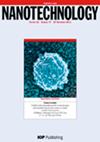Novel synthesis of α-alumina hexagonal nanoplatelets using electrostatic spray assisted chemical vapour deposition
IF 2.9
4区 材料科学
Q3 MATERIALS SCIENCE, MULTIDISCIPLINARY
引用次数: 21
Abstract
Electrostatic spray assisted chemical vapour deposition was used to synthesize well-defined hexagonal α-alumina nanoplatelets. Aluminium 2,4-pentanedionate was used as a precursor; it was dissolved in butanol to form a solution with a concentration of 0.01–0.05 M. The precursor solution was atomized and sprayed onto a heated glass substrate through an electrostatic nozzle with an electric potential between 5 and 20 kV. The decomposition of the chemical precursor was controlled by monitoring both the substrate temperature and the temperature gradient between the substrate and nozzle. Both as-deposited and annealed powders were characterized by x-ray diffraction (XRD), scanning electron microscopy (SEM) and transmission electron microscopy (TEM). The as-deposited powders were found to be amorphous aluminas. The hexagonal α-alumina platelets, with an average diameter less than a micron and an average thickness of 20–80 nm, were formed after annealing at 700 °C. The single crystalline nature of these nanoplatelets was confirmed by selected area electron diffraction and high resolution transmission electron microscopy.静电喷雾辅助化学气相沉积法合成α-氧化铝六方纳米片
采用静电喷雾辅助化学气相沉积法制备了六边形α-氧化铝纳米片。以2,4-戊二酸铝为前驱体;在丁醇中溶解形成浓度为0.01 ~ 0.05 m的溶液,将前驱体溶液通过电势在5 ~ 20kv之间的静电喷嘴雾化喷洒到加热的玻璃基板上。通过监测衬底温度和衬底与喷嘴之间的温度梯度来控制化学前驱体的分解。采用x射线衍射(XRD)、扫描电子显微镜(SEM)和透射电子显微镜(TEM)对沉积态和退火态粉末进行了表征。发现沉积的粉末为无定形氧化铝。经700℃退火后,形成了平均直径小于1微米,平均厚度为20 ~ 80 nm的六方α-氧化铝薄片。通过选择区域电子衍射和高分辨率透射电镜证实了这些纳米薄片的单晶性质。
本文章由计算机程序翻译,如有差异,请以英文原文为准。
求助全文
约1分钟内获得全文
求助全文
来源期刊

Nanotechnology
工程技术-材料科学:综合
CiteScore
7.10
自引率
5.70%
发文量
820
审稿时长
2.5 months
期刊介绍:
The journal aims to publish papers at the forefront of nanoscale science and technology and especially those of an interdisciplinary nature. Here, nanotechnology is taken to include the ability to individually address, control, and modify structures, materials and devices with nanometre precision, and the synthesis of such structures into systems of micro- and macroscopic dimensions such as MEMS based devices. It encompasses the understanding of the fundamental physics, chemistry, biology and technology of nanometre-scale objects and how such objects can be used in the areas of computation, sensors, nanostructured materials and nano-biotechnology.
 求助内容:
求助内容: 应助结果提醒方式:
应助结果提醒方式:


